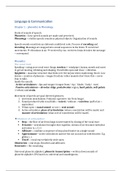Language & Communicaton
Chapter 1 – phonetcc & Phonology.
Study of sounds of speech:
Phonetics = how speech sounds are made and perceived.
Phonology = studies speech sounds as physical objects. Organization of sounds.
Speech sounds constitute an elaborate multilevel code. Process of encoding and
decoding: Meanings are mapped into sound sequences in the brain vocal tract
movements vibrations in air received by ear, receivers brain decodes the message
+ correspond.
Phonetcc
The vocal tract
Speaking = using your vocal tract (lungs, trachea (= windpipe), larynx, mouth and nose)
to get air moving, vibrating and shaping. Vocal folds open and close = vibration.
Epiglottis = mascular structure that folds over the larynx when swallowing (food). Low
larynx = creation of pharynx = tongue freedom (other mamels don’t have this = never
lean to talk).
Inside the mouth:
- Active articulators = lips and tongue (tongue front/ -tip/ -blade/ -body/ -root)
- Passive articulators = alveolar ridge, postalveolar region, hard palate, soft palate
(=velum) and avula.
Movement of speech are goal-directed gestures.
1. airstream meachanism. Pulmonic egressive (air from lungs).
2. Sound produced with vocal folds = voiced / without = voiceless (puff of air =
aspiration).
3. Velum open (=nasal sound) or not (= oral sound)
4. Active articulator: place of articulation (where constriction will be made) and
manner of articulation (what sort of constriction will be made).
Manners of artculaton :
Stop = the flow of air from lungs is interrupted by closing of the vocal tract
Fricative = articulators brought close together, stream of air becomes turbulent
and noisy (s, z, f, v)
Affricate = combine a sequence of stop plus fricative in a single sound
Approximant = active articulators narrow but not as much as with fricative. E.g.
glides, l, r.
Vowel = vocal tract relatively wide open.
Obstruents = oral stops, fricatives and affricates
Sonorants = the remaining.
Universal phonetic alphabet, phonetic transcription = written down sounds of
phonetic alphabet. IPA based on: universal and unambiguous. `
, Place of artculaton
Consonants (11):
Bilabial = lower and upper lip come together.
Labiodental = lower lip makes contact with upper teeth.
Dental fricatives = tongue tip to upper teeth (thin, then)
Alveolar fricatives = tongue tip at alveolar ridge (t,d,n,l)
Postalveolar fricatives = blade of the tongue making constriction at postalveolar (ng,
genre)
Retroflex = tip of the tongue curls back
Palatal = middle section tongue (+ blade and body) pused straight up to narrow space
between tongue and hard place (yacht).
Verlar = tongue body moves up to make constriction against velum (k, g).
Uvular = tongue body constriction further back.
Pharyngeal = constriction of tongue body toward back wall of the pharynx.
Laryngeal fricative = larynx as only articulator (h) – glottal stop (uh-oh)
Vowels
Vowels have open vocal tract. Place of articulation not really appropriate. Mostly lips
and tongue body.
High vowels = tongue body moves up
Low vowels = tongue body moves down
mid vowels = tongue body stays in the middle.
Rounding lips = rounded vowels, if not unrounded.
Tense = longer, slightly higher and produced with greater stiffening of tongue than lax
vowels.
Aspects of speech that influence stretches of sound larger than a single segment are
called suprasegmental, includes
length, long
tone, pitch of the voice creates a lot of meaning. Combined with intonation.
intonation,
syllable structure, One syllable can be defided. Necleus = most sonorous element,
the peak itself. Before that = onset. Following nucleus = coda. Nucleus and coda
together = rhyme.
Stress, linguistic stress is a prominence relation between syllables, some are
longer, louder, higher or more clearly pronounced. Unstressed syllable = foot.
fixed stress = languages in which stress is completely predictable.
lexical stress = stress is unpredictable.
paradigmatic stress = depend on what part of speech a word is (eg verb or
noun).
Acoustic phonetics
How articulators turn air movements into sounds, what happens after and how they
travel and get decoded.
Speachsounds are caused by moving air. Rate of vibration = frequency.
The vocal folds ripple in complicated patterns creating overtones (or harmonics).
Fundamental frequency = basic rate of vibration.





